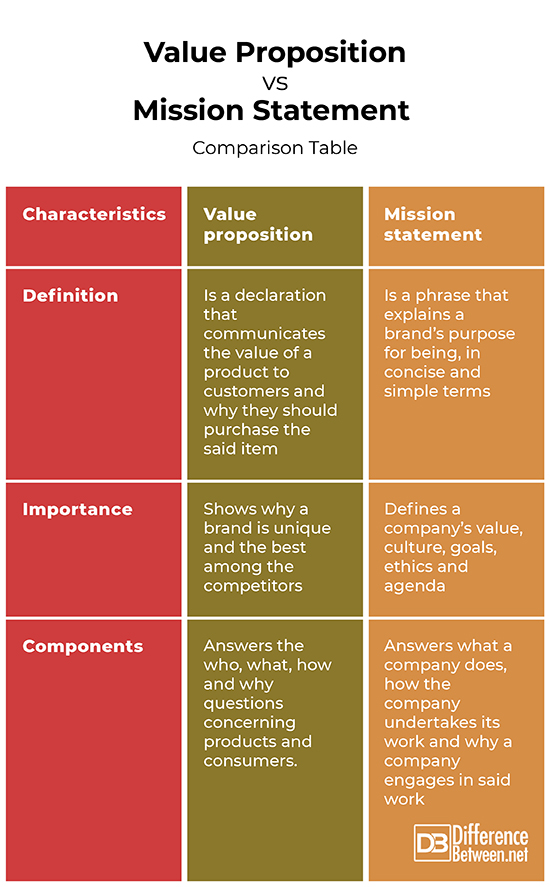Difference Between Value Proposition and Mission Statement
Brands are constantly trying to survive the apparent competition in every sector. While it all comes down to the types of services and products that are offered, how they package themselves to consumers also comes into play. Most, however, often struggle with communicating their offerings to consumers. And this can be communicated via a value proposition and a mission statement. But what is the variance between the two? Let’s see below.

What is Value proposition?
This is a declaration that communicates the value of a product to customers and why they should purchase the said item. Value propositions summarize how brands will deliver their promise and value that all the consumers will benefit from it. Value propositions show why a brand is unique and the best in the market.
Efficient value propositions are neither indirect, vague nor convey exaggerating promises. They are also keen on the level of competition in the sector and aim to stand out.
Here are 4 questions that value propositions aim to answer.
- WHAT- What problem can the product or service solve for the customer?
- HOW- How does the brand aim to solve the problem?
- WHO- Which group of customers have this problem?
- WHY- Why should a customer get the problem solved by the brand?
Value proposition also includes the consumers’ touchpoint with the brand, from the point of purchase, experience with the product and the price paid for the product.

What is Mission statement?
A mission statement explains a brand’s purpose for being, in concise and simple terms. They should be clear and catchy. As such, they are generally short and are often a short paragraph or a single sentence.
Mission statements define a company’s value, culture, goals, ethics and agenda. It is significant to all players including employees, investors, suppliers, distributors, shareholders and the entire community.
The mission statement reveals 3 things:
- What a company does- This could be a service or a product, and it is what makes the business run
- How the company undertakes its work- This should be described in a non-technical way, such that any person can understand.
- Why a company engages in said work- This helps a brand stand out from others. It should be catchy and ethical.
Mission statements can sell or ruin a company. As such, some brands go all the way to pay handsomely for a mission statement to be developed. Contrary to what most people think, mission statements are for small & large corporations, professionals, individuals and investors.
Similarities between Value proposition and Mission statement
Differences between Value proposition and Mission statement
Definition
A value proposition is a declaration that communicates the value of a product to customers and why they should purchase the said item. On the other hand, a mission statement is a phrase that explains a brand’s purpose for being, in concise and simple terms.
Importance
Value propositions show why a brand is unique and the best among the competitors. On the other hand, mission statements define a company’s value, culture, goals, ethics and agenda.
Components
Value proposition answers the who, what, how and why questions concerning products and consumers. On the other hand, mission statements answer what a company does, how the company undertakes its work and why a company engages in said work.
Value proposition vs. Mission statement: Comparison Table

Summary of Value proposition vs. Mission statement
A value proposition is a declaration that communicates the value of a product to customers and why they should purchase the said item. It shows why a brand is unique and the best among the competitors. On the other hand, a mission statement is a phrase that explains a brand’s purpose for being, in concise and simple terms. It defines a company’s values, culture, goals, ethics and agenda.
FAQs
What are examples of the value proposition?
The experience IS the Product- Apple iPhone
The Smartest Way to Get Around- Uber
What is the difference between a value proposition and a positioning statement?
Value proposition refers to the emotional, self-expressive and functional benefits that consumers get from a brand. On the other hand, positioning statement defines how a brand is different from other competing brands.
What is the value proposition?
Value proposition is declaration that communicates the value of a product to customers and why they should purchase the said item
- Difference Between Profit Center and Investment Center - July 2, 2022
- Difference Between Anti-Trust and Anti-Competition - June 6, 2022
- Difference Between Stocktaking and Stock Control - June 6, 2022
Search DifferenceBetween.net :
Leave a Response
References :
[0]Ashley Guillard. Business Strategy Journal: A Step by Step Guide to a Successful Business Plan & Strategy. Live in Fantasy Land, LLC., 2018. https://books.google.co.ke/books?id=1_RaDwAAQBAJ&pg=PT44&dq=Difference+between+value+proposition+and+mission+statement&hl=en&sa=X&ved=2ahUKEwj6mpiWxYb2AhUWD-wKHWeFBNMQ6AF6BAgDEAI#v=onepage&q=Difference%20between%20value%20proposition%20and%20mission%20statement&f=false
[1]Jain L & Zimmermann A. Architecting the Digital Transformation: Digital Business, Technology, Decision Support, Management. Springer Nature, 2020. https://books.google.co.ke/books?id=YI7zDwAAQBAJ&pg=PA150&dq=Difference+between+value+proposition+and+mission+statement&hl=en&sa=X&ved=2ahUKEwj6mpiWxYb2AhUWD-wKHWeFBNMQ6AF6BAgFEAI#v=onepage&q=Difference%20between%20value%20proposition%20and%20mission%20statement&f=false
[2]William G. Forgang. Strategy-specific Decision Making: A Guide for Executing Competitive Strategy: A Guide for Executing Competitive Strategy. Routledge, 2015. https://books.google.co.ke/books?id=x2emBgAAQBAJ&pg=PA54&dq=Difference+between+value+proposition+and+mission+statement&hl=en&sa=X&ved=2ahUKEwj6mpiWxYb2AhUWD-wKHWeFBNMQ6AF6BAgIEAI#v=onepage&q=Difference%20between%20value%20proposition%20and%20mission%20statement&f=false
